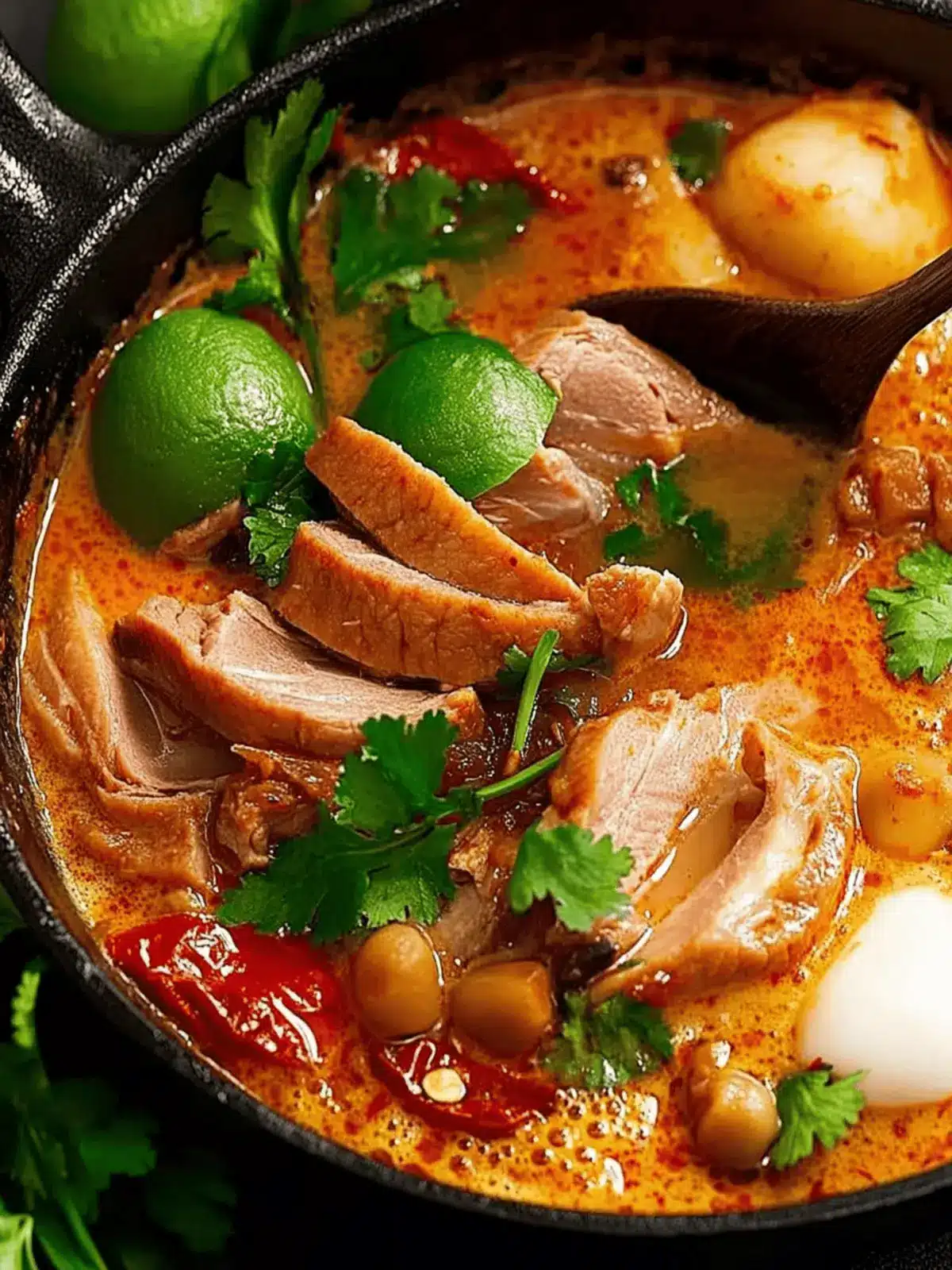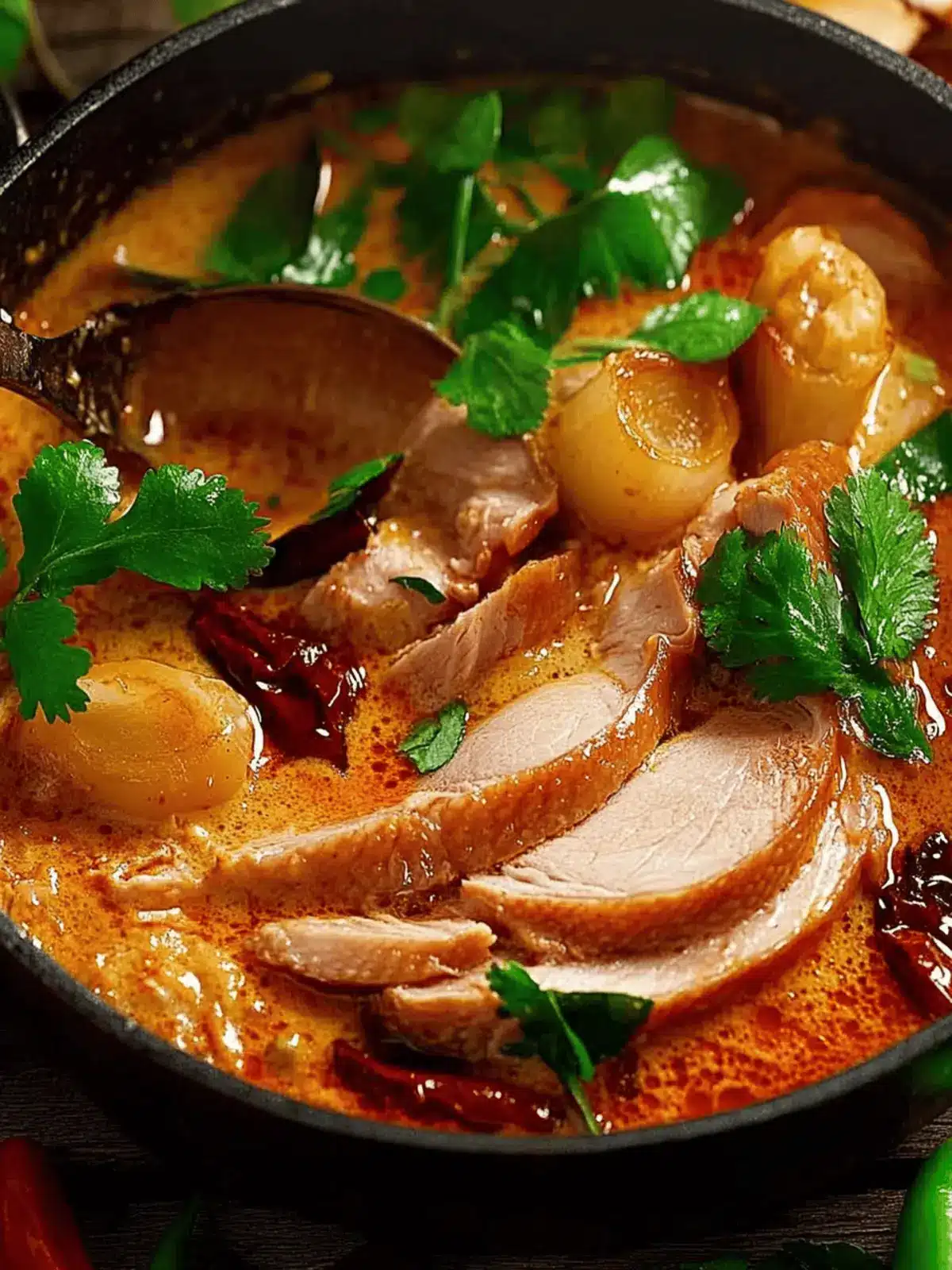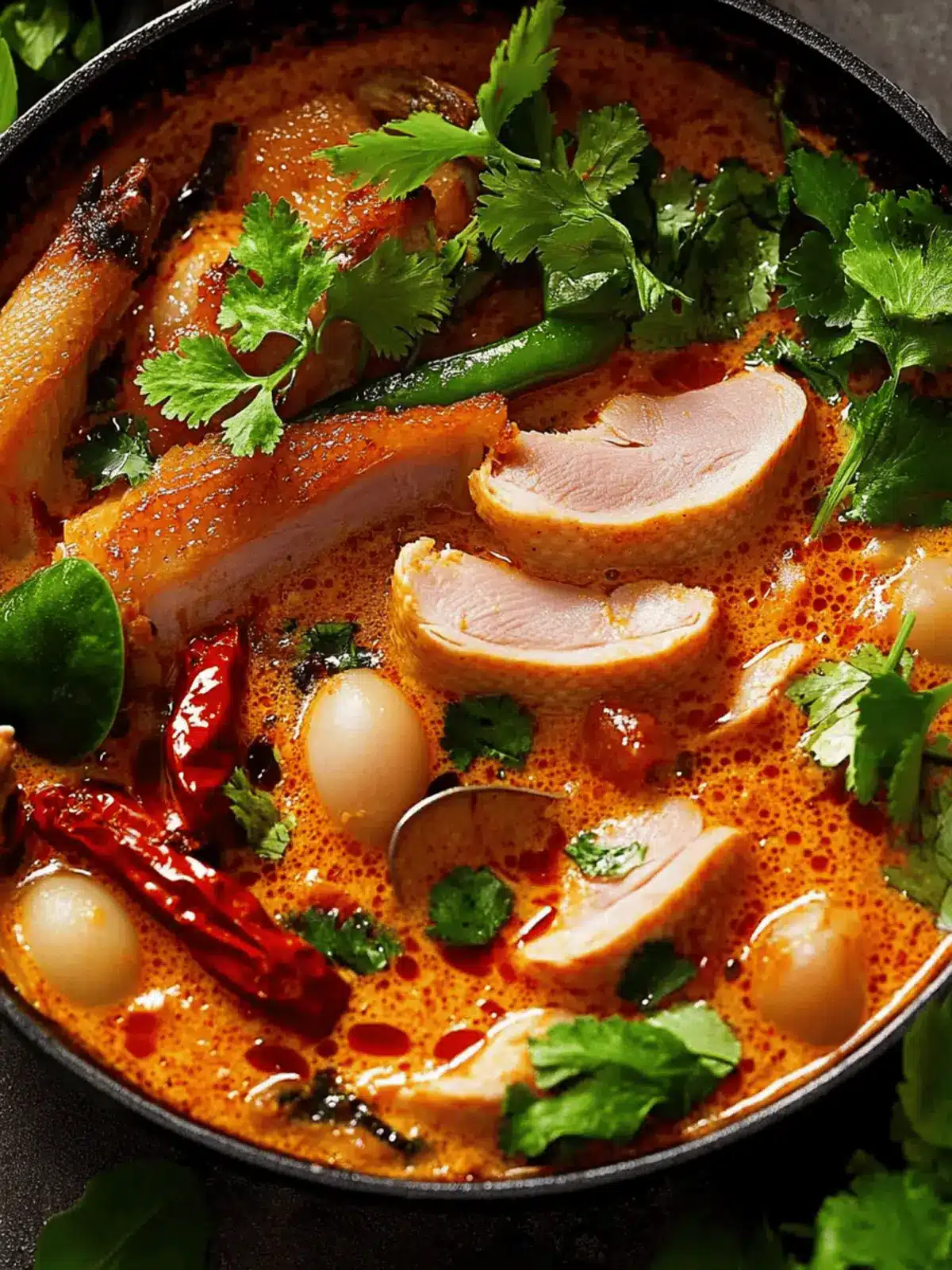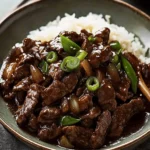When a cozy evening calls for something extraordinary, I often turn to my Thai Red Duck Curry. The moment you sauté garlic and ginger, your kitchen fills with an irresistible aroma that promises an adventure in flavor. What I love most about this recipe is the perfect harmony between the tender duck and the luxurious coconut curry—enhanced by the unexpected sweetness of lychees or pineapples. It’s a dish that whispers “luxury” without demanding an extravagant budget.
Whether you’re entertaining close friends or simply indulging in a quiet dinner at home, this curry delivers rich taste and comforting warmth that feels like a warm hug from the inside out. Join me as we dive into this rich tapestry of Thai flavors, and let’s make your next meal something to remember!
Why is Thai Red Duck Curry a must-try?
Irresistible Aroma: The moment you start sautéing garlic and ginger, your kitchen transforms into a fragrant paradise that whets your appetite.
Luxurious Flavor: This curry brings together tender duck and rich coconut milk, creating a sauce that’s both indulgent and comforting.
Tropical Touch: Elevate your dish with the unique sweetness of lychees or pineapple, adding that unexpected burst of flavor.
Crowd-Pleaser: Perfect for hosting or a simple dinner, it’s a dish that impresses without a fuss.
Quick & Easy: Simple steps lead to a stunning plate, making it ideal even for weeknight cooking.
Versatile Ingredient Swap: Customize with your favorite fruits or veggies, ensuring this recipe never gets old!
Thai Red Duck Curry Ingredients
For the Duck
• Duck Breasts (500g / 1 lb) – The star of your Thai Red Duck Curry, choose skin-on and boneless for optimal flavor.
• Cooking Salt/Kosher Salt (1/4 tsp) – Enhances the taste of the duck beautifully.
• White Pepper (1/4 tsp) – Adds a mild warmth; swap with finely ground black pepper if needed.
For the Curry Sauce
• Thai Red Curry Paste (115g / 4 oz) – The essential base flavor for the curry; opt for Maesri brand for authenticity or use homemade.
• Garlic (2 large cloves, finely grated) – Infuses the dish with aromatic goodness.
• Fresh Ginger (2 tsp, finely grated) – Adds a fresh, zesty kick to your curry.
• Chicken Stock/Broth (1 cup, low sodium) – Creates the savory liquid base for the sauce.
• Coconut Milk (400ml / 14 oz, full fat) – Provides creaminess and rich coconut flavor; avoid low-fat for best results.
• Makrut Lime Leaves (6-8, crushed by hand) – Essential for authentic Thai flavor; save extras in the freezer.
• White Sugar (2 tsp) – Balances the savory notes, adding a hint of sweetness.
• Fish Sauce (2 tsp) – Imparts a salty depth, crucial for a well-rounded flavor.
For the Vegetables and Garnish
• Green Beans (120g / 4 oz, trimmed and cut in half) – Adds vibrant color and crunch; feel free to mix in other seasonal veggies.
• Thai Basil Leaves (1 cup, lightly packed) – Offers authentic herbaceous hints; regular basil can work in a pinch.
• Lychees (8-12, whole, peeled, seed removed) – Provides delightful sweetness; fresh or canned works perfectly.
• Pineapple Pieces (1 1/4 cups, preferably fresh) – An alternative to lychees that brings its own tropical charm.
For Serving
• Jasmine Rice – Serve as a comforting side; 2 cups of raw rice is recommended for a satisfying base.
• Garnishes: Extra Thai basil leaves, coriander/cilantro (optional), finely sliced large red chili (optional), and lime wedges (recommended) for that extra zing.
How to Make Thai Red Duck Curry
-
Prepare Duck: Score the skin of the duck breasts gently and season well with salt and white pepper. In a cold, ungreased pan, place them skin-side down with a weight on top; cook over medium-low heat for about 10 minutes, until the skin turns golden brown and crispy.
-
Oven Finish: Preheat your oven to 180°C (350°F). Once the duck is perfectly golden, transfer it to the oven for 8 minutes, or until the internal temperature reads 60°C (140°F). Let the duck rest afterward for optimal juiciness.
-
Make Curry Sauce: In the same pan, sauté the Thai red curry paste in the reserved duck fat, adding the finely grated garlic and ginger. Cook for 4-5 minutes, letting the aromas blend beautifully. Next, pour in the chicken stock and reduce it by half, then stir in the coconut milk, fish sauce, sugar, and crushed lime leaves. Simmer for 2 minutes, allowing the flavors to meld.
-
Add Vegetables: Stir in the green beans and cook them until tender, which should take about 3 minutes. Then, gently fold in the lychees or pineapple pieces, stirring for just 1 minute to heat through without losing their delicate sweetness.
-
Serve: Slice the resting duck breast and fan it artistically on a plate, spooning the vibrant sauce over the top. Garnish with fresh basil, cilantro, and sliced chili for a pop of color and flavor. Serve alongside fluffy jasmine rice for a complete meal!
Optional: Drizzle a little extra coconut milk on top before serving for added richness.
Exact quantities are listed in the recipe card below.
What to Serve with Thai Red Duck Curry?
When it comes to creating the perfect dining experience, complementing your main dish with delightful sides is key to a memorable meal.
- Fluffy Jasmine Rice: This traditional accompaniment soaks up the savory coconut sauce, enhancing every bite of your rich curry.
- Spicy Thai Salad: A fresh, crunchy salad adds a zesty contrast that balances the curry’s creaminess while introducing vibrant flavors.
- Crispy Spring Rolls: These tender bites, filled with vegetables or shrimp, provide a delightful crunch and a burst of fresh taste, perfect for nibbling between curry bites.
- Thai Cucumber Relish: This sweet and tangy relish cuts through the richness of the curry, offering a refreshing lift that awakens your palate.
- Steamed Bok Choy: Lightly steamed, these greens bring a tender chew and brighten your plate visually while contributing essential nutrients.
- Mango Sticky Rice: For dessert, this classic Thai sweet dish pairs beautifully with the curry’s flavors, offering a sweet finish that lingers joyfully on your palate.
- Chilled Coconut Water: Refreshing coconut water not only hydrates but complements the tropical notes in your curry, making it an ideal beverage choice.
- Thai Iced Tea: With its robust flavors and creamy texture, this vibrant tea is an iconic companion that rounds out the meal beautifully.
Expert Tips for Thai Red Duck Curry
-
Crispy Duck Skin: Start cooking with a cold, ungreased pan for the duck. This renders fat and ensures crispy skin—an absolute delight in your Thai Red Duck Curry.
-
Juicy Duck: When scoring the duck skin, avoid cutting into the flesh. This prevents drying out and keeps the texture juicy and tender during cooking.
-
Adjust Spice Level: Curry paste can vary in heat; start with half the amount if you’re unsure about spice tolerance. You can always add more later in your Thai Red Duck Curry.
-
Serve Immediately: For the best texture, serve right after assembling the dish. The skin stays crispy if not submerged in sauce for too long.
-
Frozen Makrut Lime Leaves: If you have extra crushed Makrut lime leaves, freeze them! They maintain their flavor and can be used for future curries.
Make Ahead Options
These Thai Red Duck Curry components are perfect for meal prep enthusiasts! You can season and score the duck breasts up to 24 hours in advance, storing them uncovered in the refrigerator to maintain skin crispiness. Additionally, you can prepare the curry sauce (coconut milk, curry paste, and stock) up to 3 days ahead, just be sure to refrigerate it in an airtight container to preserve its rich flavors. When you’re ready to serve, simply cook the duck and finish the curry with the green beans and lychees or pineapple. This way, you’ll enjoy all the delightful flavors of Thai Red Duck Curry with minimal effort on busy weeknights!
Thai Red Duck Curry Variations
Make this dish your own by experimenting with different flavors and ingredients!
- Dairy-Free: Use coconut or almond milk in place of regular cooking cream for a lighter, dairy-free version.
- Fruit Swap: Replace lychees with fresh peaches or mangoes for a new fruity twist that adds brightness to the dish.
- Veggie Boost: Add bell peppers, snap peas, or zucchini for a colorful mix of vegetables that enhance both texture and nutrition.
- Heat Level: For extra spice, stir in some sliced bird’s eye chilies or a drizzle of sriracha just before serving.
- Protein Alternative: Try chicken or even tofu instead of duck to make it light and accessible for varied dietary preferences.
- Nutty Flavor: Toss in some roasted peanuts or cashews at the end for a delightful crunch that complements the creamy curry.
- Curry Paste Variety: Opt for green or yellow curry paste for a different flavor profile while keeping the essence of Thai cuisine intact.
- Herb Variations: Mix in cilantro or mint with Thai basil for exciting, fresh herb notes that elevate your curry’s aroma.
How to Store and Freeze Thai Red Duck Curry
Fridge: Store leftovers in an airtight container for up to 3-4 days. Allow the curry to cool completely before sealing to maintain its delicious flavors.
Freezer: Freeze the Thai Red Duck Curry in a leak-proof container for up to 3 months. Make sure to leave some space at the top for expansion when freezing.
Reheating: Reheat gently in a saucepan over low heat, stirring occasionally to ensure even warming. Add a splash of coconut milk if needed to restore creaminess.
Original Sauce Taste: For the best experience, enjoy the duck curry fresh, but with proper storage techniques, you can still relish the rich flavors of this delightful dish after freezing!
Thai Red Duck Curry Recipe FAQs
What kind of duck is best for this curry?
I recommend using skin-on, boneless duck breasts for the best flavor and texture. They provide a rich, savory quality that perfectly complements the coconut curry sauce. If you prefer a lighter option, you can also substitute duck with chicken breasts or tofu for a vegetarian alternative.
How should I choose ripe lychees or pineapples?
For lychees, look for those that are slightly firm with a vibrant pinkish-red color. They should have a fragrant, sweet aroma. Avoid ones with dark spots all over, as they may be overripe. For pineapples, choose one that is slightly soft to the touch and emits a sweet scent at the base; this indicates ripeness and sweetness.
How should I store leftovers from my Thai Red Duck Curry?
You can store leftovers in an airtight container in the refrigerator for up to 3-4 days. Make sure to let the curry cool completely before sealing the container to maintain flavor and freshness. When you’re ready to enjoy it again, just gently reheat it without boiling to avoid overcooking the duck.
Advertisement
Can I freeze Thai Red Duck Curry? If so, how?
Absolutely! You can freeze the Thai Red Duck Curry in a leak-proof container for up to 3 months. Before freezing, allow the curry to cool completely and leave some space at the top of the container for expansion. When you’re ready to use it, simply thaw overnight in the refrigerator and reheat gently on the stovetop, adding a splash of coconut milk if needed to restore its creamy consistency.
What should I do if the curry is too spicy?
If you find your curry has turned out too spicy, don’t worry! You can mellow the heat by stirring in a bit more coconut milk to create a creamier texture. Alternatively, adding a teaspoon of sugar can also help balance the flavors. Another option is to serve it over jasmine rice, which will absorb some of the spice while adding a comforting element to the meal.
Are there any dietary considerations I should keep in mind?
When it comes to allergies, it’s essential to check the ingredients in the Thai red curry paste, as some brands may contain gluten or shellfish. If you’re serving this dish to someone with dietary restrictions, opt for a gluten-free curry paste. Also, if you have pets around, keep in mind that ingredients like garlic and onions can be toxic to them, so be sure to keep leftovers out of reach.
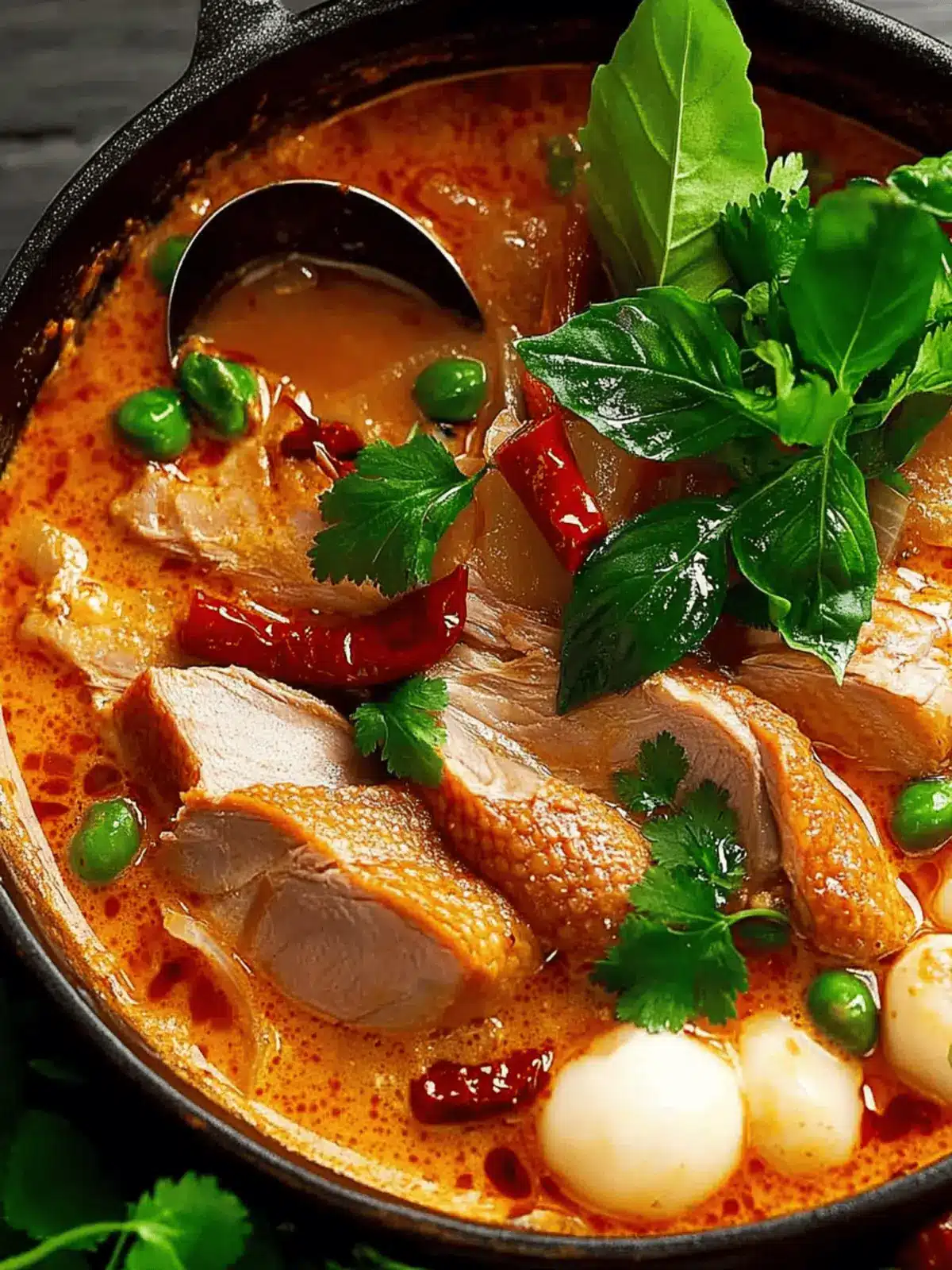
Savory Thai Red Duck Curry with Tropical Lychees Delight
Ingredients
Equipment
Method
- Score the skin of the duck breasts gently and season well with salt and white pepper. In a cold, ungreased pan, place them skin-side down with a weight on top; cook over medium-low heat for about 10 minutes, until the skin turns golden brown and crispy.
- Preheat your oven to 180°C (350°F). Once the duck is perfectly golden, transfer it to the oven for 8 minutes, or until the internal temperature reads 60°C (140°F). Let the duck rest afterward for optimal juiciness.
- In the same pan, sauté the Thai red curry paste in the reserved duck fat, adding the finely grated garlic and ginger. Cook for 4-5 minutes, letting the aromas blend beautifully. Next, pour in the chicken stock and reduce it by half, then stir in the coconut milk, fish sauce, sugar, and crushed lime leaves. Simmer for 2 minutes.
- Stir in the green beans and cook until tender, about 3 minutes. Gently fold in the lychees or pineapple pieces, stirring for just 1 minute to heat through.
- Slice the resting duck breast and fan it on a plate, spooning the vibrant sauce over the top. Garnish with fresh basil, cilantro, and sliced chili. Serve alongside fluffy jasmine rice.

